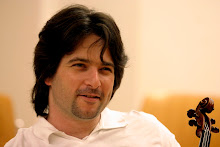VM9
An egg will always be just an egg, but with the right ingredients and a bit of inspiration it could be turned into a culinary masterpiece.
Nothing like a short trip to another county and a few public lessons to get one’s prosaic gene into overdrive.
My visit to the music school in
Students are now facing with so much information they seem lost. They have books, lectures and seminars on periodic playing, soloists play their own personalized version while different teachers tell them what to do and dismiss what was told to the student by previous teachers. You get the idea…
So here are my thoughts:
The most important thing in music is sound. It should be attractive, beautiful or if the music does not demand beauty: interesting. Sound is your visit card and essentially who you are as a musician. It is the prologue and the entire book, the overture and themain event. Sound is the ingredient with which you cook the egg.
Our job is to produce a clear and concise interpretation of masterpieces and to infuse life and personality into the notes written on the page. However, in the search for the right technique and the correct stylistic way of trilling we must not forget that we are playing music that should be understood by all, including the unprofessional audience, your ticket buying, music loving public.
So what is the correct interpretation of Bach or Mozart? Who knows? Certainly not I, but whichever way you choose to play should make musical sense throughout the entire piece so the public have better chance of following your idea.
Take any Mozart concerto, for example. Everyone want to play Mozart with the correct style, and everyone seem to know what the correct style is, except that they all play different from each other. I do not ask myself anymore “what is the correct style?”, but “what is style?” and “why is this music still alive while so many other composers remained obscure?
What is similar between Bach and Mozart, for example, is that they broke the rules of what we perceive as style today. They used the ‘style’ as a stepping stone and rose above it, bending and sometimes breaking the rules when it suited them. Many of Bach’s chorals are written against all rules of voicing. Try and imitate this in c theory classes and your teacher will admonish you for writing parallel fifths and other sins. Same goes for breaking sequences or moving into unexpected harmonies, basically what makes Bach’s music so exquisite and eventually timeless compared all other composers of his time (incidentally his son was considered a much more successful composer in his life time. Perhaps in a typical youthful rebellion he actually followed the rules…).
When Mozart wrote his music classical style was just “the style we play that is all-the-rage”. What made his music so interesting and funny (funny how everyone say Mozart’s music is suppose to be ‘funny’ but so many play it so ‘seriously’). In his time his innovations were probably seen as a bold move against ‘establishment’ at best or simply as ‘common’ music by the more conformist critics. Yet we play Mozart today as if was the norm, as if everyone used this style. We play it correctly and miss all the funny innovations he inserted into the piece.
If you want to tell an interesting story, especially if you are going for a joke, you must make sure everyone understands the language you are speaking, but today’s audience do not have the innate sense of eighteenth century style, and so they do not follow the essential life of the music.
How do we convey the sense of style? How do we show abnormality without a sense of ‘normality’? In essence we create a sense of expectation as we play any kind of musical sentence. We do it through timing, loudness, vibrato, harmonic movement and even facial and body expression. Sometimes we ‘fulfill’ the expectation (going into the Tonica or reaching a musical climax) and sometimes we surprise the audience and change direction abruptly, making them feel a certain element is coming then surprising them. Mozart’s concertos, for example, are full of such surprises, something many of us spectacularly miss.
How do we create a surprise?
Your audience instinctively looks for five elements in your playing: sound (most important of all), a line (thematic material they can whistle or sing), a sense of rhythm to follow, a sense of harmony and perhaps the most overlooked element: articulation.
You must be aware of these five elements and try to install a sense of them in your audience from the beginning of the piece. You must choose, for example, if a sequence moving ‘down’ the harmonic line means crescendo or diminuendo and follow your decision throughout the movement. This instills a sense of ‘style’ in your audience who will have a better chance to detect when you ‘break’ the sequence. Yet if you do not play the sequences up to the breaking point as if it is going in the ‘normal’ direction you will not create an effect when you do break it. If you pull and push a piece rhythmically you will lose the effect of actual Rubati or Rit.
To be continued… (my flight is about to land)

